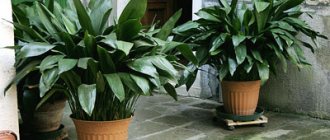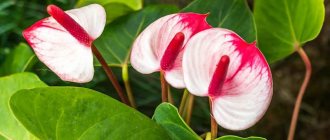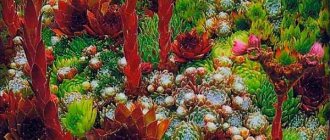A rare flower does not have its own history, full of legends and superstitions. The stone rose, often used in landscape design, is no exception. How to care for it at home?
Stone rose is an exclusively popular name used in Russia and the CIS countries
Botanical description of stone rose (juvenile)
Stone rose is an exclusively popular name used in Russia and the CIS countries. tenacious or hare cabbage, echeveria is also used Translated from Latin as “always alive.”
This unusual succulent consists of many lanceolate, succulent leaves that look like scales. They are located around a straight stem in the form of large or small rosettes (in diameter from 1 to 15 cm in diameter). Star-shaped flowers with a double perianth and many stamens ripen into ovoid fruits from 8 to 20 pieces.
Looking carefully at the plant, you understand why it was named so. Its pattern of leaves resembles a blossoming rose. Often found in the Caucasus and southern North America.
Signs and superstitions associated with the stone rose
Echevaria has a rather controversial reputation: some believe that the plant does not carry negative emotions, others are afraid to plant hare cabbage at home or in the garden, because they believe in its negative energy. It must be said that the second superstition arose due to the fact that stone roses are often planted in cemeteries. This choice is not surprising, the plant is practically unpretentious, it thrives on stones, it does not need to be watered often, it survives drought calmly and at the same time looks great. But, like any other living creature, the survivor is capable of absorbing bad emotions (but also positive ones).
We also recommend reading:
16 most popular indoor plants Physalis: description of species and varieties, technology for growing from seeds Spruce in landscape design: the best ornamental varieties and characteristics of cultivation Kalanchoe: description of types and characteristics of care at home
And so the plant has had a good reputation since Antiquity. In Ancient Rome, the flower was called a talisman; they believed that it could ward off evil from its owner. This superstition was not forgotten in the later era of the Early Middle Ages: Charlemagne ordered it to be planted on the roofs of houses to “scare off” lightning. So the stone rose became the first “lightning rod”.
There is no need to be afraid of keeping a flower at home because of existing superstitions. In order for him to “cleanse” himself of accumulated negativity, it is enough to simply talk to him often and treat him with love. Then the stone rose will only be a joy; it will become a true decoration for the room.
Echevaria has a rather controversial reputation: some believe that the plant does not carry negative emotions, others are afraid to plant hare cabbage at home or in the garden, because they believe in its negative energy
What plants can a succulent be placed next to?
The succulent is used in the garden to decorate alpine slides and flower beds. Most often, the plant is used for group plantings together with other ornamental crops. But a flowerbed that combines several species with different shapes and colors of leaves looks no less impressive.
Secrets of caring for a stone rose in the garden
Any garden flowers need to be carefully looked after, only then will they be able to develop properly. And although the survivor is not too whimsical, it is also demanding of certain factors and they should be taken into account.
- The peculiarity of succulents is that they perfectly accumulate water and are able to survive long periods of dry soil without any problems. Therefore, you do not need to water the plant every day, but once or three times a week during particularly hot months. Do not overdo it, otherwise the roots will begin to rot, which almost always leads to death. Keep an eye on the lower leaves, they are the ones who begin to respond to overflow first.
- Carry out the process itself under the plant, the outlet should not be wet.
- Loosening the soil around the crop has the most beneficial effect on it. This helps get rid of weeds, the roots begin to breathe better, and ventilation increases, which prevents moisture accumulation. But keep in mind that the rhizome is almost on the surface, so carry out the process extremely carefully.
- Remove dead plants and weeds in a timely manner.
- What attracts gardeners to the stone rose? It does not need to be fertilized, unlike many other crops. Fertilizing worsens the saturation of the leaves and makes the plant more vulnerable to frost. Only three-year-old flowers need help. Buy a special preparation for succulents and cacti, use only half the volume of the indicated dose.
Light-loving stone roses must be prepared for cold weather. Delicate and delicate flowers will simply die in the first winter. The process itself is not too complicated.
- Prepare shelter. Plastic bottles with a volume of 5 liters are perfect for protection. Cut off the top of them.
- Punch holes with an awl 1 cm from the cut. There shouldn’t be too many of them; five to seven pieces is enough.
- If such a bottle is too large, select another container that is suitable in width. If one container is not enough, then take several pieces.
- Turn the vessel upside down and place it above the flower bed. To prevent it from being blown away by the wind, secure the bottle with metal rivets or pins. That's what the holes are for.
- Carefully cover the one-year-old juveniles with spruce branches, and they will survive their first winter in an open area just fine.
Florarium decoration
A beautiful and original composition can be created using several miniature succulents in a florarium. It can be created independently or purchased ready-made. The composition can be composed of various types of echeveria, cacti, Kalanchoe, young plants and other plants.
Work on creating a composition is carried out in the following order:
- First, the glass container is disinfected with alcohol.
- Fine drainage is poured onto the bottom of the container in a layer a quarter of its height, on top - a layer of soil of the same thickness, lightly compact both layers.
- It is imperative to have a drainage layer at the bottom of the container, even if it is small and small plants are planted.
- Next, plants are placed on the ground, the roots of which are lightly sprinkled with soil, which is carefully compacted.
- Pre-boiled and cooled decorative pebbles and sand are laid out on the ground (colored sand will look more beautiful). You can also put special stones for the aquarium.
- If the top layer of the florarium will be soil for the aquarium, it is better to use colored soil - it will turn out very beautiful.
- All that remains is to decorate the composition by installing figurines or floral decorative elements.
Decorating a florarium using a stone rose.
The place for the florarium should be brightly lit. The composition should be watered rarely, even less often than an echeveria growing in an open pot is watered; the soil should not become waterlogged.
If the container and soil are not disinfected, the plants may be affected by fungal infections, which quickly develop in the limited space of the florarium.
Gallery: stone rose flower (56 photos)
Methods for propagating stone roses
Most people are afraid to purchase several specimens at once, but then they realize the value and beauty of these plants and think about buying a few more succulents. But the tenacious creature reproduces easily, so you don’t have to resort to store services and try to get new stone roses yourself.
There are several methods of propagation: seeds, cuttings or leaves.
Vegetative (cuttings or leaves)
- Choose the healthiest and most beautiful succulent in your flower bed. Separate from it the leaf located closer to the trunk. He shouldn't be too young.
- Or cut off the top of the bush, tearing off the lowest leaves.
- Dry the workpieces for several hours.
- At this time, mix vermiculite and sand in equal proportions. Moisturize it.
- Stick the cutting or leaf into the prepared soil and place it in a well-ventilated and sunny place.
- So the plant should stand for a month. Moisten the soil periodically.
- During these 30 days, in good conditions, an outlet should appear. It will take 2 to 3 months for its final formation. The maternal part will dry out at this time.
- Transplant the new organism into a separate pot with cactus soil.
Seeds
- For this method you will need peat and sand. Place their mixture in a suitable box.
- Stick the seeds shallowly into the ground (4-5 mm). Spray the soil with a spray bottle. Cover everything with film.
- The container is left in a warm (20-25 degrees) and lighted room.
- Moisten the soil as needed.
- After two weeks, the succulents will appear above the ground, and the young ones are transplanted when 2-3 well-developed leaves are formed.
Choosing a location and landing rules
Juvenile does not require special conditions; the main thing for it is to find a sunny place without an excess of moisture. From the rays of the sun, the roses have a rich color, but grow to a medium size. If they are placed in the shade, they turn pale, lose their decorative effect, but become larger. There are varieties that, with a slight darkening, take on a more colorful appearance.
For growing in open ground, loose and breathable soil is suitable. There must be good drainage so that water does not linger in the soil. Fertility does not matter; the flower will grow on soil poor in nutrients, but will be small in size. Before planting, the area must be prepared, which will make maintenance easier. It is cleaned of weed rhizomes. To do this, it is better to use a pitchfork. You can simply loosen the ground without digging. Sand and fine gravel are added to it.
To plant the young, they dig holes corresponding to the size of the long taproots. Then the rhizomes are placed in the holes, the flower is pressed to the surface. Some varieties have short adventitious roots. In this case, they are simply pressed against loose soil. Planted plants should be watered so that they take root faster. Then moisturize little by little.
The planting pattern depends on the variety of sempervivum: some grow gigantic, while others have small rosettes. At first, the young ones can be planted densely after 5-10 cm, and when they grow up, they can be transplanted. The second option is to make the distance larger, and pour sand between the plants and lay out pebbles.
Options for using stone roses in landscape design
Succulents can pleasantly diversify the look of a garden, adding zest and some warmth to it. The uniqueness of the plant lies in the fact that it is very beautiful, but at the same time it has a green or burgundy tint that is pleasant to the eye. It’s hard to overdo them, so they can be used in absolutely any volume.
- As already mentioned, echveria does not combine well with other flowers due to the fact that it does not receive enough light. Therefore, you need to carefully select other crops. It’s better to do without them, the stone rose is already quite original.
- The combination of pebbles (decorative stones) and hare cabbage is the most impressive. Tender and succulent succulents look very beautiful together with neutral and harsh gray-brown tones. Therefore, if you doubt your abilities as a decorator, choose young ones. It requires very little effort and material, and the result will be wonderful.
- Stone roses look great in individual pots. There is absolutely no need to buy new ones! Broken or outdated containers will do, as long as they are well cleaned. For beauty, you can paint “patches” in especially worn places. Place it on the ground side up and let your imagination run wild! Gardeners even use old shoes, and succulents look great in them.
Stone rose goes well in any composition. They can be used with anything (as long as they follow the prescribed rules).
Stone rose goes well in any composition
How does echeveria reproduce?
The simplest and most reliable way to propagate echeveria is to separate the lateral daughter rosettes from the mother bush. This is done during plant transplantation in the spring. The rosettes are cut with a knife, which must first be sterilized, then each cut must be sprinkled with activated carbon powder, dried and planted in the ground the next day.
Rules and features of stone rose propagation.
Features of growing stone roses at home
Juveniles are also excellent for home growing. It should be remembered that in indoor conditions the flower takes root very well, but after that it can no longer be transplanted to an open area, as it simply will not take root.
In principle, the rules of care do not really change:
- Choose exclusively southern sides so that the survivor can receive enough sunlight every day. Even on western and eastern windows there will be a shortage, and on northern windows the succulent will completely wither.
- If you want his plant, but you don’t have enough sun at home, then build a source of additional lighting.
- Juveniles need to be watered very rarely. Just two or three times in the winter months and once a week in the summer is enough.
- Don't think there isn't enough moisture. It is more dangerous to overwater a flower than to underwater it, since it tolerates drought very well and rarely dies from lack of water.
- Use a mixture of sand, peat or leaf soil as soil. Loosen it carefully from time to time.
Since stone roses are practically not susceptible to pests and diseases, they will appeal to lovers of indoor plants. Weeds and cockchafers do not threaten them, the main thing is not to overwater them so that the root system does not rot.
Recommendations
If you have a small area, then 2-3 outlets will be enough to completely green it by the end of the season. Since the plant multiplies quickly, there is no point in purchasing many seedlings. The cost of one socket is 300-400 rubles, depending on the type.
Stone roses are sold in many flower shops.
Juvenile is an excellent plant for the garden plot. It does not require scrupulous care and looks beautiful in garden compositions of various sizes.











